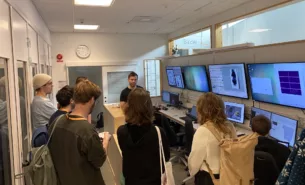A newly developed sample delivery system at MAX IV lets researchers study the properties of aerosol particles. With this knowledge, they can further understand the health and climate effects of soot from burning fuels for transportation or natural emissions.
Dr Kim Cuong Le from the Division of Combustion Physics at Lund University is conducting one of the first experiments using the new Aerosol Sample Delivery System. She works on setting up flames that will generate soot particles which are led through a pipe into the experiment chamber and investigated using the X-ray beam from MAX IV.
“We are conducting in-depth research on the surface properties of aerosol soot utilizing X-ray photoelectron spectroscopy (XPS) at FinEstBeAMS,” says Dr Le.

Soot is produced from the incomplete combustion of hydrocarbons, for example, fossil fuels. Its properties vary based on combustion conditions, including factors like fuel type, fuel-to-oxidant ratio, temperature, and pressure.
“The knowledge we gain from our experiments at FinEstBeAMS equips us and fellow researchers in various fields to estimate the impact of soot and control combustion processes. Given that soot is a significant contributor to both climate change and numerous health issues, understanding its properties and formation in diverse combustion processes is of critical importance,” explains Dr Le.
An experiment like this one takes a lot of preparation and precautions.
“This was our first beamtime at MAX IV. We’ve been met with exceptional support from various teams, including safety, plumbing, and gas technicians, with special commendation to the dedicated staff at FinEstBeAMS,” says Dr Le.
The experiments were successful and have inspired continued investigations.
“Our future trajectory includes the development of X-ray absorption techniques, to be seamlessly integrated with XPS and other laser-based diagnostic methods like online Raman scattering, UV-Vis absorption, and Laser-induced incandescence and fluorescence at our Division of Combustion Physics. This will grant us a comprehensive understanding of particle properties,” concludes Dr Le.
Light Materials Synergy Award
After the writing of this news story, Dr Kim Cuong Le and her colleague Dr Calle Preger recieved 200kSEK funding from the Light Materials Synergy Award call for “Harnessing Cutting-Edge Light sources in Lund for Insights and Applications of Synthesized Cabonaceous Nanoparticles” to continue their research.




